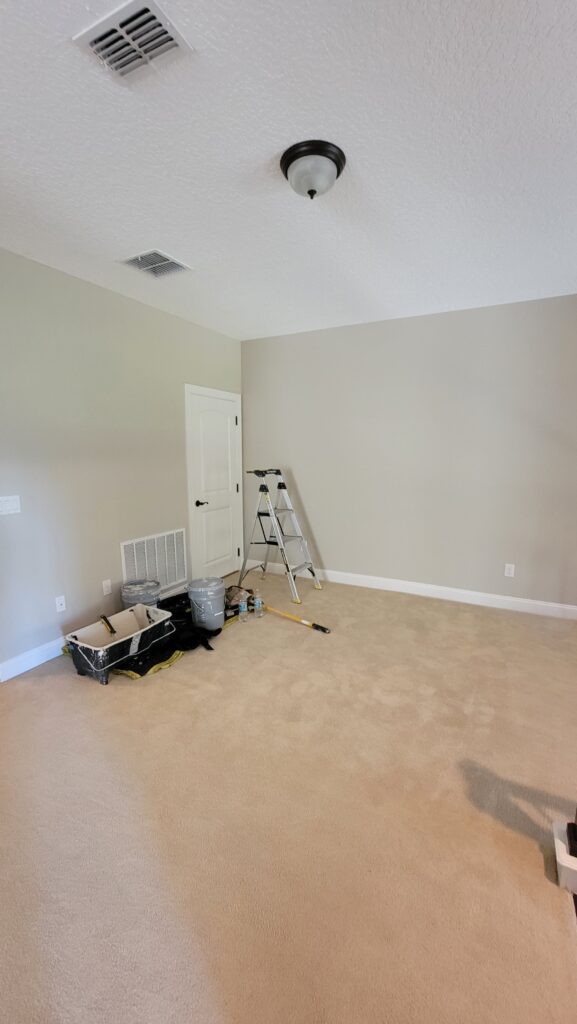Interior design thrives on thoughtful choices, from furniture placement to color palettes. Among the most effective techniques for transforming a room without an overwhelming renovation is the use of accent walls. These bold focal points can define a space, guide the eye, and reflect personal taste. Whether you lean toward classic sophistication or modern minimalism, accent walls offer a low-commitment, high-impact strategy. For homeowners looking to enhance their space with ease, working with a professional interior painting service is often the best starting point to achieve flawless results.

What is an Accent Wall?
An accent wall is a single wall within a room that differs in color, texture, or material from the other walls. Rather than blending into the background, it draws attention and adds visual interest. Its purpose isn’t just decorative—accent walls can influence the mood, define a space, or highlight architectural features.
Accent walls can be created using paint, wallpaper, wood paneling, stone, tile, or even fabric. Each approach brings a different vibe to the space, from cozy rustic tones to sleek modern finishes.
The Psychology of Color in Accent Walls
Color plays a central role in how a space feels. Warm tones—like reds, oranges, and yellows—evoke energy, comfort, and sociability. Cool tones—like blues, greens, and purples—tend to create a sense of calm, making them ideal for bedrooms or reading nooks.
Neutrals like grays, beiges, and charcoals offer timeless sophistication and versatility. Deep tones such as navy, emerald, and charcoal gray can create depth and contrast, while lighter shades can make a space feel airy and open.
Accent walls provide the perfect opportunity to explore bold or unconventional colors without overwhelming the room. Instead of painting an entire space in a vibrant hue, focusing on one wall lets you enjoy a touch of drama while maintaining balance.
Choosing the Right Wall
Not all walls are suited to become accent walls. The best candidates often feature:
- A natural focal point (e.g., a fireplace, built-in bookshelf, or headboard)
- Ample open space
- Architectural interest (vaulted ceilings, arches, or niches)
Avoid choosing a wall with multiple interruptions, like doors or large windows, unless those features add to the composition. The goal is to create a visual anchor, not visual clutter.
Accent Walls and Room Function
Each room serves a different purpose, and accent walls can be used to support that purpose visually and emotionally. Here’s how accent walls can be tailored to specific rooms:
Living Room
Use an accent wall to frame the TV unit, fireplace, or seating area. Textured finishes like brick or wood paneling can introduce warmth and character.
Bedroom
The wall behind the bed is a popular choice. A contrasting color or fabric panel adds luxury and depth, enhancing the intimacy of the space.
Dining Room
An accent wall can make a formal dining space more dynamic. Patterns, rich colors, or even a gallery wall setup can foster conversation and style.
Kitchen
Use materials like tile or shiplap to define a breakfast nook or backsplash zone. This is a great way to combine design and practicality.
Home Office
Encourage focus by using deep, grounded hues. An accent wall in a study can also display floating shelves, certificates, or artwork.
Paint Techniques for Accent Walls
Paint remains one of the most popular and cost-effective ways to create an accent wall. Here are some techniques that work well:
Color Blocking
Combine two or more contrasting colors on one wall in geometric patterns. This is a modern, playful approach ideal for contemporary spaces.
Ombre
A gradient effect from dark to light adds softness and a sense of transition, perfect for bedrooms or meditation rooms.
Stripes
Horizontal stripes can make a space feel wider, while vertical stripes add height. Use painter’s tape to ensure clean lines.
Matte vs. Gloss
A subtle contrast in finish, such as a matte wall with a glossy pattern over it, adds dimension without changing color.
Material-Based Accent Walls
Not every accent wall has to be painted. Materials can add texture, depth, and a tactile quality. Here are some excellent options:
Wood Paneling
Shiplap, reclaimed wood, or slatted panels add warmth and rustic charm. Painted wood offers a sleek, modern aesthetic.
Wallpaper
Available in countless prints and textures, wallpaper allows you to introduce patterns and styles that might be difficult to replicate with paint.
Stone and Brick
Natural materials like brick or stone introduce a sense of permanence and grounding. Ideal for fireplaces or industrial-themed interiors.
Tile
In bathrooms and kitchens, tile accent walls not only look striking but also serve functional purposes like moisture resistance.
Fabric or Upholstered Panels
Soft to the touch and rich in texture, fabric wall panels can bring luxury into bedrooms or lounges.
Lighting and Accent Walls
Lighting can either enhance or diminish the impact of an accent wall. Proper placement makes all the difference. Here’s how to optimize lighting:
- Spotlights or track lighting aimed at the accent wall can amplify its prominence.
- Wall sconces can frame a painted or textured wall with elegance.
- Natural light should be considered—walls that receive daylight might reflect color differently than shaded ones.
Combining lighting with your accent wall ensures it gets the attention it deserves and sets the right tone for the room.
Patterns and Shapes
Patterns add movement, rhythm, and complexity to accent walls. When executed correctly, they can become pieces of art.
- Chevron or herringbone patterns in wood create elegant movement.
- Geometric designs using tape and paint give a modern edge.
- Murals can depict anything from abstract shapes to nature scenes, bringing personality to the space.
- Stencils allow for repetition and consistency in floral or symmetrical designs.
Patterns can be bold or subtle depending on your desired outcome, and they work well in nurseries, offices, and eclectic living rooms.
Accent Walls for Small Spaces
Accent walls can do wonders in small or awkward spaces. Rather than making a space feel smaller, a well-placed accent wall adds structure and visual interest.
- Narrow Hallways: Use darker hues or artwork to break up monotony and elongate the space visually.
- Small Bedrooms: A patterned or painted wall behind the bed anchors the room without the need for large furniture.
- Tiny Powder Rooms: Bold wallpaper or glossy paint can make a statement in spaces that often get overlooked.
The trick is balance—avoid overwhelming the space with too many competing colors or textures.
Coordinating Décor with Accent Walls
A successful accent wall doesn’t exist in isolation. Its design should tie in with the rest of the room. Here are key strategies:
- Color Echoing: Use accessories—like throw pillows, rugs, or curtains—in similar hues to the accent wall.
- Material Matching: If you’re using brick or wood, consider matching furniture or trim to harmonize the look.
- Art and Frames: Choose artwork that complements or contrasts tastefully with the wall color or texture.
- Furniture Placement: Avoid cluttering the accent wall with oversized furniture. Let it breathe and act as a focal point.
When the wall and décor are in sync, the entire room feels intentional and well-crafted.
Common Mistakes to Avoid
While accent walls offer creative freedom, they come with their share of pitfalls. Here’s what to steer clear of:
- Too Many Accent Walls: Keep it to one per room. Multiple feature walls can confuse the eye and dilute the effect.
- Poor Color Choices: Avoid using colors that clash with your existing furniture or flooring.
- Ignoring Room Function: Bright orange might energize a kitchen, but it could feel jarring in a bedroom.
- Lack of Balance: If an accent wall is bold, balance it with understated furniture or neutral accessories.
Sticking to a cohesive design concept ensures the accent wall enhances rather than disrupts the space.
Seasonal Flexibility
Accent walls can evolve with the seasons. While materials like wood and stone are permanent, painted walls or removable wallpaper allow for seasonal updates.
- Spring/Summer: Opt for fresh pastels or botanical prints.
- Fall/Winter: Shift to deeper tones like burgundy, hunter green, or navy.
Interchangeable accents, such as artwork or fabrics, can also shift the mood without repainting.
Accent Walls in Open Floor Plans
In open concept spaces, accent walls help define functional zones without constructing physical barriers. For example:
- A different color behind the dining area separates it from the kitchen.
- A wood-paneled accent wall can differentiate a home office corner.
- Painted columns or partial walls can mark transitions while maintaining flow.
Accent walls offer structure in otherwise undefined layouts.
Using Accent Walls for Branding or Personal Expression
For those with a strong personal style or for home-based businesses, accent walls provide an outlet for identity.
- Monograms or word art in a home office
- Family photo collages on a gallery wall
- Company colors or logos in creative workspaces
These personal touches elevate functionality with a sense of ownership.
When to Seek Professional Help
While accent walls can be DIY-friendly, certain projects benefit from the precision and expertise of professionals. Large-scale murals, textured materials, or multiple finishes require the right tools and techniques to avoid costly mistakes.
When in doubt, especially with paint or material installations, working with professionals ensures lasting results and clean execution.
Why Choose Affordable Actions Home Services LLC?
At Affordable Actions Home Services LLC, we treat every home as a canvas ready to reflect your vision. We don’t just apply paint or install panels—we create environments where personality, comfort, and style meet. Whether you’re aiming to refresh a single wall or redefine your space entirely, we approach each project with meticulous attention to detail and a commitment to craftsmanship.
Our team takes the time to listen, understand your aesthetic goals, and deliver accent walls that go beyond trend, becoming timeless statements in your home. From bold painted features to elegant wood or textured finishes, we bring your ideas to life with precision and care.
Your home deserves more than ordinary. Let’s make it exceptional—one wall at a time.

